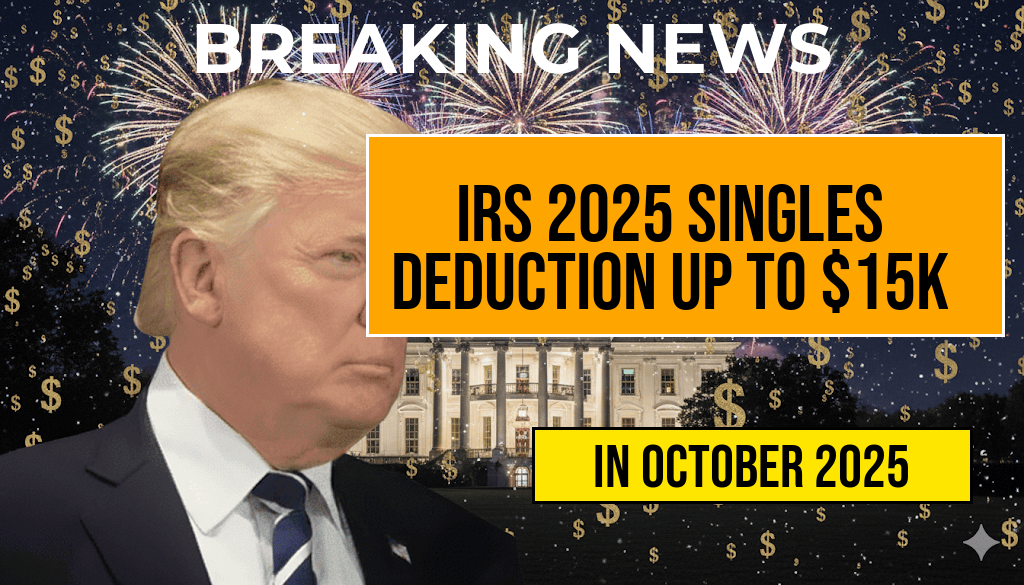IRS Announces 2025 Inflation Adjustments, Allowing Singles to Deduct Up to $15,000
The Internal Revenue Service (IRS) has released its annual inflation adjustments for the 2025 tax year, revealing significant changes in deduction limits for individual filers. Notably, single taxpayers will be able to claim a deduction of up to $15,000 on certain expenses, a substantial increase from previous years. This adjustment could translate into potential tax savings exceeding $1,650 for individuals in the highest applicable tax brackets, depending on their income and specific circumstances. The new figures reflect the IRS’s effort to keep tax benefits aligned with inflation, making it more advantageous for taxpayers to claim deductions and potentially reducing their overall tax liability.
The IRS’s inflation adjustments aim to prevent bracket creep, where inflation unintentionally pushes taxpayers into higher tax brackets, increasing their tax burden despite no real increase in purchasing power. For 2025, these updates are particularly noteworthy as they influence various deductions, credits, and exemption amounts, shaping the landscape of individual taxation. Tax experts advise filers to review these changes carefully, as they could impact planning strategies for both current and future filings.
Understanding the 2025 Deduction Limits and Their Impact
The key highlight for many taxpayers is the increase in the maximum deduction available to singles. The IRS’s adjustment for the 2025 tax year raises the standard deduction, itemized deduction thresholds, and other relevant limits to account for inflation. For individual filers, the maximum deductible amount on qualifying expenses now stands at $15,000.
This increase means that many taxpayers who previously claimed lower deductions may now benefit from larger write-offs, reducing taxable income and potentially lowering overall tax bills. For example, if a single taxpayer claims the full $15,000 deduction and falls within a 22% tax bracket, the tax savings could amount to approximately $3,300. However, the actual benefit depends on individual circumstances, including other deductions, credits, and income levels.
Potential Tax Savings Based on Tax Rates
The table below illustrates how the $15,000 deduction could translate into savings across different tax brackets:
| Tax Rate | Tax Savings |
|---|---|
| 12% | $1,800 |
| 22% | $3,300 |
| 24% | $3,600 |
| 32% | $4,800 |
| 35% | $5,250 |
| 37% | $5,550 |
As demonstrated, a single taxpayer in a 37% tax bracket could see savings of over $5,550 by claiming the maximum deduction. These figures underscore the importance of understanding how inflation adjustments can significantly influence tax planning strategies.
Additional Inflation-Adjusted Figures and Changes
Beyond the deduction limit, several other key figures have been adjusted for inflation:
- Standard Deduction for Singles: Increased to $15,000
- Personal Exemption: Reinstated at a limit of $4,000
- Earned Income Tax Credit (EITC): Adjusted thresholds to reflect inflation
- Phase-out Limits for Various Credits: Increased to prevent inflation-related reductions
These updates aim to help lower and middle-income taxpayers retain more of their earnings amid rising living costs.
Implications for Tax Planning and Filing
Tax professionals recommend that taxpayers consider these inflation adjustments when preparing their 2025 filings. Since the deduction limit has increased, some individuals might find it beneficial to accelerate deductible expenses or contribute more to retirement accounts to maximize their benefits. Additionally, increased thresholds for credits and exemptions can influence eligibility for various tax benefits.
Taxpayers should also review their overall financial situation, as larger deductions could impact the phase-out of certain credits, such as the Child Tax Credit or the American Opportunity Credit. Consulting with a tax advisor can help optimize strategies and ensure compliance with the latest IRS regulations.
Resources for Taxpayers
For detailed information on the 2025 inflation adjustments, taxpayers can visit the official IRS website or consult authoritative sources such as [Wikipedia’s page on the Internal Revenue Service](https://en.wikipedia.org/wiki/Internal_Revenue_Service) for background context. Staying informed about these changes can make a significant difference in managing tax liabilities effectively.
As the IRS continues to adjust figures annually to reflect inflation, understanding these shifts remains crucial for effective tax planning. With the increased deduction limits and thresholds, individuals have new opportunities to reduce their taxable income and maximize savings in the upcoming tax season.
Frequently Asked Questions
What is the new IRS inflation adjustment for 2025?
The IRS inflation adjustment for 2025 allows singles to claim a deduction of up to $15,000, reflecting updated figures to account for inflation.
How much can single filers potentially save in taxes with this deduction?
Based on the tax rate applied, single filers could save over $1,650 in taxes, depending on their income and taxable amount.
Who qualifies as a single filer for this deduction?
To qualify as a single filer, an individual must file as single or head of household and meet the IRS criteria for these filing statuses in 2025.
Will the deduction limit change in future years?
The deduction limit is adjusted annually for inflation, so it may increase or decrease in subsequent years based on the IRS inflation adjustments.
How does the tax rate impact the actual savings from this deduction?
The tax rate directly influences your tax savings; higher rates result in greater savings, meaning the potential over $1,650 savings is contingent on your specific tax bracket.

Leave a Reply